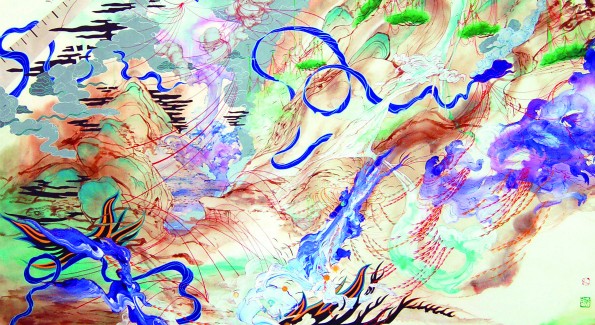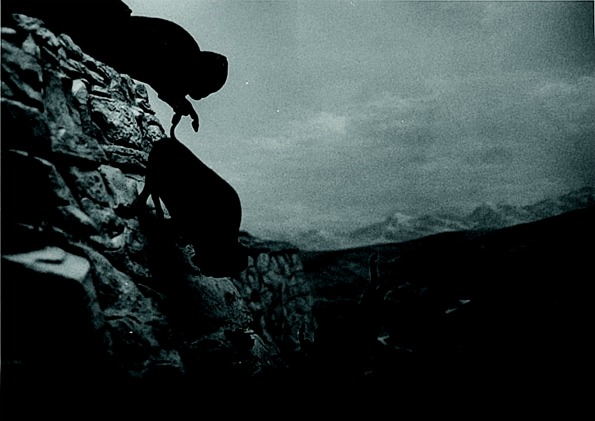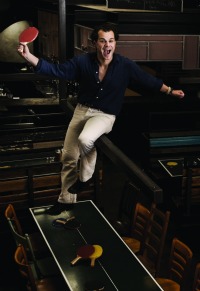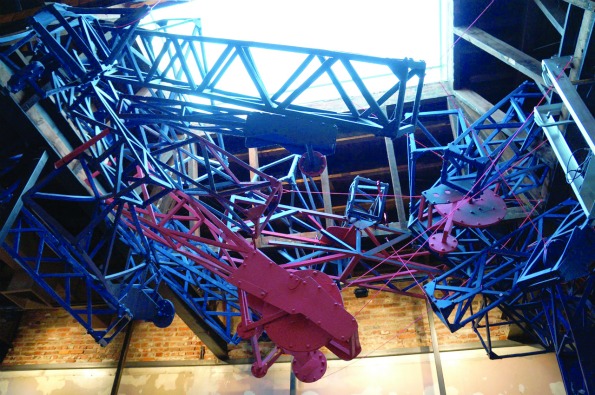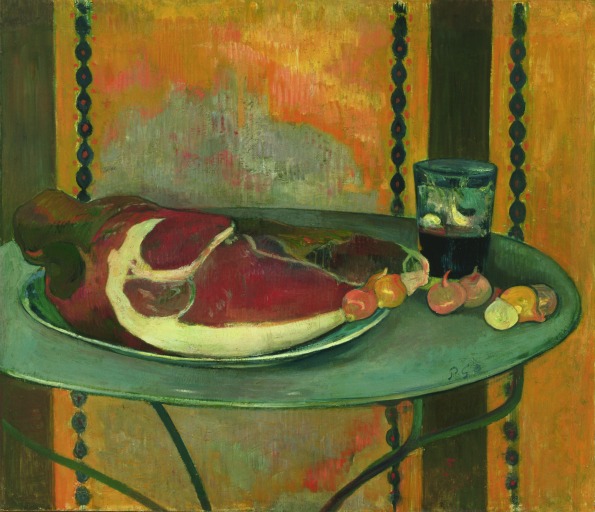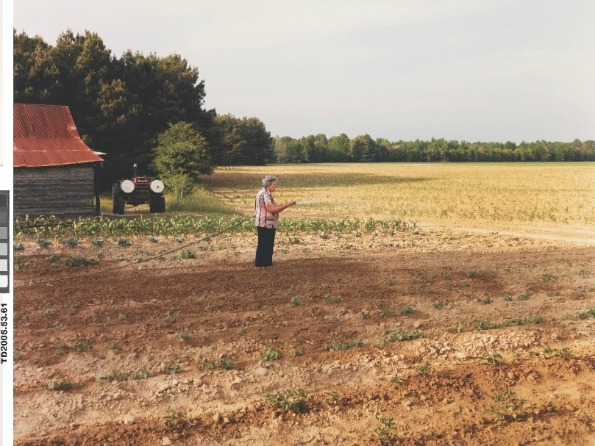Prominent collectors unveil two moving & inspiring pieces from their own collections.

Rashid Johnson & Hank Willis Thomas "Portrait of Two American Artists as Young Negro Scholars," 2008 digital C-print (Courtesy of the Rubell Collection, Miami, Fla.)
ANDREA POLLAN
Director and founder of Curator’s Office, an innovative concept dedicated to contemporary art and culture.
Washington Life: What made you fall in love witheach piece?
Pollan: When Jiha Moon started to unroll her piece, because it is so huge, I was absolutely speechless. The Johnson & Thomas portrait is such a stunning, elegant and commanding image of two very important American artists. It doesn’t hurt that they both are incredibly handsome.
WL: What makes each important?
Pollan: Jiha’s piece is definitely a museum-caliber artwork, given its size and complexity, and it has the provenance of having been exhibited at The Mint Museum in her first important solo museum exhibition. The title of the photograph belies the artists’ intentions to challenge historic perceptions of African Americans, and the confidence with which they display themselves in their carefully orchestrated environment is both confrontational and reflective.
WL: What is unique about each piece, both in general and in comparison to works by the same artist?
Pollan: Jiha’s piece is a synthesis of every thing she been working on in terms of cultural collision and explorations of eastern and western painting and drawing tropes up to that point in 2007. Rashid and Hank collaborate on very limited bases with other artists.
WL: How do people react?
Pollan: When art-world and regular people alike encounter Jiha’s piece in our living room, they generally say “Whoa!” People gravitate towards the work, feeling drawn in and challenged by Hank’s direct gaze and compelled by Rashid’s pensive, stern, and focused visage.
KATE DAMON
Founder of kaze design and a boardmember of Transformer, passionate about color, community and ridding the world of single-use plastic.
Washington Life: What made you fall in love with each piece?
Damon: I love that Billy’s piece is made of found objects re-purposed into art. Noguchi’s “THE MOON” was love at first sight; I’ve always had a special
connection with the full moon, and I love color.
WL: What makes each important?
Damon: Billy is an important American artist – if only I had bought some of those earlier paintings! “THE MOON” is currently on view in an exhibition “2:46 and thereafter” – a collaboration between Transformer and Tokyo-based artist collective DANDANS, highlighting emerging Japanese artists’ responses to the March 2011 earthquake and tsunami that struck Japan’s north-east coast.
WL: What is unique about each piece, both in general and in comparison to works by the same artist?
Damon: While Billy often works with collected imagery or objects, this piece was specifically made for a show called “Bauble” featuring 31 artists showing pieces all inspired by toys. Color is a strong theme running throughout Kazumasa Noguchi’s work.
WL: How do people react?
Damon: Most people love Billy’s piece, and some have questions. I’ve juxtaposed with a beautiful stainless sculpture by William Halliday, so the contrast of texture and color makes them both pop. “THE MOON” isn’t here yet, it is on view at Pepco’s Edison Place Gallery, (702 8th Street NW) through March 25th. It’s an intense piece that takes your breath away when you put it in context – the full moon was shining in the sky the night before the earthquake struck in Japan, as if there were a trade-off between the illumination and the thousands of lives lost.
JAMES ALEFANTIS
Restauranterur, producer, collector and Transformer board president.
Washington Life: What made you fall in love with each piece?
Alefantis: David Wojnarowicz’ photograph was offered to me by a stranger, a year after Victoria Reis and I, through Transformer gallery’s front window, began to show a video by the same artist, which had just been censored by the Smithsonian and started a national outcry. As soon as I saw it, I knew Mia Feuer’s “Suspended Landscapes” would look amazing in Comet Ping Pong, where it defies gravity by jutting down out of the ceiling!
WL: What makes each important?
Alefantis: “Untitled, (Buffalo)” is arguably the most important work in my collection. It is a small photograph, taken by the artist in 1988 of a diorama from the Museum of Natural History of buffalos being driven off a cliff, which came to symbolize a protest of the government
and a time of extreme cultural division. “Suspended Landscapes” embodies all the sense of awe and play that I showcase at Comet Ping Pong; fascinatingly, this work is really now a piece of public art!
WL: What is unique about each piece, both in general and in comparison to works by the same artist?
Alefantis: This 1988 platinum print, regarded as one the artist’s best works, was printed by master printer Sol Lopes. This is an early work by 20-something artist Mia Feuer, who has achieved great notoriety in the contemporary art world (including being represented by Conner Contemporary Art.)
WL: How do people react?
Alefantis: So far, I have not shown “Untitled, (Buffalo)” to anyone! My first reaction was that it is so important I should donate it immediately to the National Gallery of Art or the Hirshhorn Museum and Sculpture Garden, but I calmed down and decided to keep it for a while to see how my feelings evolve, since living with a work always changes the way you see it. With Mia’s piece, it’s awe – that it can stay up, then smiles and fun!
DOROTHY KOSINSKI
Director, The Phillips Collection
Washington Life: What made you fall in love with each piece?
Kosinski: I love Paul Gauguin’s “The Ham,” that Duncan Phillips [founder of The Phillips Collection] purchased in 1951, especially the intense orangepink color, the decorative beaded elements and the primitive subject of ham, onions and a beaker of red wine. Frank Gohlke’s photo has special meaning for me; it is a gift from the artist, whom I know, a wedding gift inscribed in 1987 to me and my husband Thomas.
WL: What makes each important?
Kosinski: Gaugin’s stunning canvas and straightforward subject would surely have appealed to a collector so passionate about beautiful painting. Gohlke’s piece captures a clear narrative about the USA.
WL: What is unique about each piece, both in general and in comparison to works by the same artist?
Kosinski: Perhaps there is a connection between my admiration for the Gauguin and the Gohlke … they are both simple subjects, straightforward images, humble but beautiful, mesmerizing works of art.
WL: How do people react?
Kosinski: The Gaugin glows, has a coloristic intensity. Frank’s marvelous image is simple, clear, poignant.


